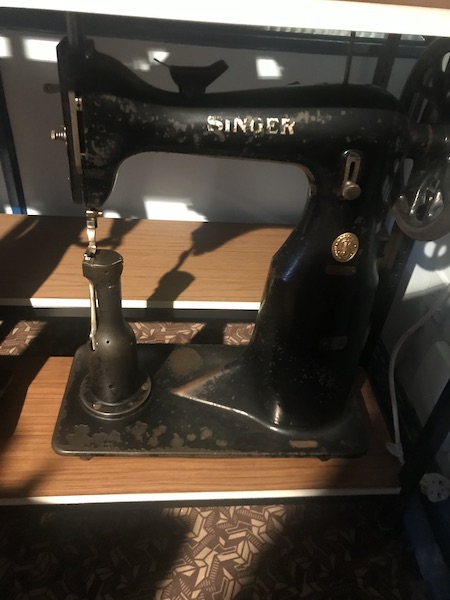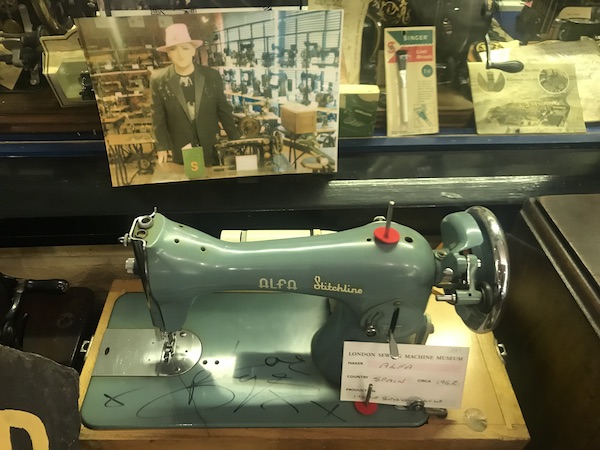The London Sewing Machine Museum
We split up on Saturday, our last day in London. My mother and sister went to Kew Gardens and the girls and I went to the British Museum. We were in the Egyptian exhibit, looking at the sarcophagi, when DD#2 again spotted a sewing machine:
The card accompanying this machine noted that it had recently been added to the museum’s Egyptian collection as an example of mid-20th century progress in that country that allowed women to own and operate their own sewing businesses. I love the decals on this machine, but please move that lever down so the machine isn’t sewing in reverse!
We spent the morning at the museum, ate lunch, and then the girls went off to see London Bridge and I headed south to the sewing machine museum. DD#1 had found a phone app called City Mapper, which was a huge help in navigating our way around London. You give the app the location you want to travel to, and it tells you the best way to get there by tube, bus, taxi/Uber, or walking. Armed with the information I needed, I set off for the tube station and a 30-minute ride south.
The London Sewing Machine Museum is only open on the first Saturday of the month from 2-5 p.m. I got off the tube at Tooting Bec at 1:50 p.m. and spent the next nine minutes and 12 seconds searching for the museum, which is only about 100 yards from the station. There is no sign to hint at its location, however. My only clue was the Wimbledon Sewing Machine Company building and the haberdashery next door. I finally saw a line forming at the sewing machine company and joined it. The very nice British woman standing next to me in line asked me if I had come all the way from America just to visit the museum.
I did not know how to answer that question. Um, yes?
The door was soon opened by an older gentleman and we were ushered up some stairs (past several sewing machines) and into two rooms stuffed full of hundreds more machines. If my sister wants heaven to be the market at Fortnum and Mason, I want it to be this museum.
We were encouraged to wander around and look at—and even touch!—the machines on display while waiting for our guide to start her lecture. I took a few pictures:
Each machine is accompanied by a hand-lettered card indicating the model and its intended use.
I think a post bed machine could be very useful:
My sister has been asking me what machine is in the intro to Call the Midwife on PBS. I am pretty sure it is this Singer 45K. The card noted it was a factory machine used for making lingerie.
These Cornely embroidery machines are so fascinating! There is an entire Facebook group devoted to them. This is the same machine that made the embroidery on the apron I bought in Florence two years ago.
Our guide (I think her name was Lauren) was incredibly informative and entertaining. In this picture, she is standing in front of the original T.A. Rushton sewing machine storefront that was brought here to the museum. Ray Rushton, son of the Thomas Rushton who started this business, owns the Wimbledon Sewing Machine Company where the museum is located. Ray is well up in years (late 80s?) and still working. Lauren works at the haberdashery next door, which is run by Ray’s son.
Ray Rushton seems to be the go-to person in the UK whenever a sewing machine is needed for some kind of media production. (He provided one of the machines used in the Downton Abbey series.) And those All Saints clothing stores, like the one in Notting Hill, that have sewing machines on display in their windows? Apparently, Ray provided all of those machines—something like 8500 of the them—to the company. A collective groan went up from those of us in the group when we heard that, but Lauren reminded us that at one point, sewing machines were as common as toasters and if All Saints hadn’t used them in their displays, they likely would have ended up as scrap. (I don’t mind that they are on display, but All Saints welded the machines to make them non-operational and that hurts my heart a bit.)
The green Alfa, below, is one identical to the machine owned by Boy George’s mother when he was little. He wanted to use it in a video, so Ray provided it and asked Boy George to autograph it when he sent it back.
I related this story to my family afterwards and DD#2 said, “I don’t know who Boy George is,” which immediately made me feel like a dinosaur.
This machine was owned by Charlie Chaplin’s mother, clearly well-used and well-loved.
The museum features a couple of extremely valuable pieces, all behind glass, of course. One is the machine that was custom made for Queen Victoria’s daughter on the occasion of her wedding in 1865. Another is the first free-arm machine. And this, clearly, is the pride of the museum:
Why would such a humble-looking contraption have pride of place in a sewing machine museum? The story of the development of the sewing machine is complicated and convoluted enough that I am not going to rehash it here. If you’re curious and want to read more, start with Singer and the Sewing Machine: A Capitalist Romance by Ruth Brandon. The Sewalot website also has a wealth of information. (Spoiler alert: Isaac Merritt Singer was kind of a jerk.)
The machine shown in the picture, above, is reputed to be only one of four in the entire world and believed to have been designed and built by Barthélemy Thimonnier in the first half of the 1800s. Poor Barthélemy was a terribly unlucky entrepreneur. His factory was set on fire by a group of disgruntled seamstresses who were worried that his invention would put them out of work. He never was able to make a commercial success of his machine. This particular machine was discovered in the basement of an abandoned sewing factory in Argentina. It was purchased by the Rushtons and brought to England. Thimonnier’s machine may not have been a great success, but it was an important milestone in the development of what we now know of as the modern sewing machine.
Remember that machine in Edinburgh with the unfamiliar decal set? The London Sewing Museum has one, as well:
I spoke with Ray after the tour and asked him what the design was called. He said he thinks it is known as Forget-Me-Not.
I spotted the only Necchi-related item I saw in the whole of the UK. It was inside the reproduction storefront, so I couldn’t get any closer than this picture. The Brits weren’t big fans of Necchis, apparently.
I am so glad I got to see the machines in this museum. I also took a few moments to wander around the warehouse area of the Wimbledon Sewing Machine Company, which has what seems like acres and acres and acres of industrial sewing machines. I could have spent days in there. Eventually, though, I had to leave the museum and leave the UK and come home to Montana.
**************************************************
We had another uneventful flight home from Heathrow to Seattle on Sunday. I dropped DD#1 off at her apartment and DD#2 off at her friend’s house, where she is staying for the summer while she works at one of the Nordstrom stores. (She doesn’t really want to stay in Seattle, but this opportunity presented itself, so she took it.) I collapsed into bed at a hotel and was on the road home by 5 a.m. the next morning. My time now is being spent out in the garden—it’s amazing how quickly weeds grow in a week!—and getting my sewing space reorganized.
One of the projects I am also planning for this summer is to take one of the beaten-up Singer machines in my collection and strip it down and repaint it. I’ll be sure to document that process here when it happens.











